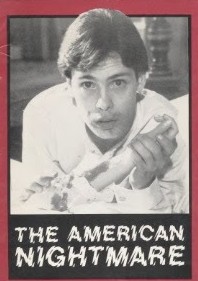 Edited by ROBIN WOOD, RICHARD LIPPE (Festival of Festivals; 1979)
Edited by ROBIN WOOD, RICHARD LIPPE (Festival of Festivals; 1979)
Here was have what may be the most widely discussed yet least read genre study of all time. Readers of non-fiction books and articles about horror cinema have likely seen THE AMERICAN NIGHTMARE referenced, as I’m sure have most David Cronenberg fans—Cronenberg has bitched at length about this book and its editor, the late Robin Wood, who’s became well-known among genre scholars for the anti-Cronenberg views he airs in THE AMERICAN NIGHTMARE. As to why the book is so obscure, the reason is simple enough: it was a 100-page booklet given out to patrons of the 1979 Toronto Film Festival that was never made available to the public. It’s also an over-intellectualized bore.
To be fair, THE AMERICAN NIGHTMARE deserves credit for being one of the first publications of its kind. Back in 1979 the idea of writing scholarly analyses on horror and exploitation movies was somewhat novel (THE PSYCHOTRONIC ENCYCLOPEDIA OF FILM and Re/Search’s INCREDIBLY STRANGE FILMS, the tomes generally credited with popularizing such fare, were still several years in the future). This explains why the book was so widely discussed, but doesn’t change the fact that its contents are of scant interest to anyone outside the academic set.
Over-intellectualizing horror movies is always a mistake. While I despise the derisive manner in which so many mainstream film critics treat horror cinema, it’s a fact that such films generally aren’t made by or for intellectuals.
Clearly nobody told Robin Wood. He makes his intent clear in the opening paragraph of THE AMERICAN NIGHTMARE’S introduction, invoking the “confluence” of Marx and Freud, and “the recognition that social revolution and sexual revolution are inextricably linked and necessary to each other.” The horror film, Wood argues, offers an ideal representation of this confluence. Elsewhere in the introduction Wood castigates Cronenberg’s SHIVERS and THE BROOD for their “reactionary” politics, with the latter film dismissed as “the precise antithesis of the genre’s progressive potential.”
Of the rest of the book, Andrew Britton contributes a perilously long-winded dirge on “The Symbolism of Evil” that invokes William Blake, Nathaniel Hawthorne and Herman Melville, along with brief references to some popular horror movies (which are secondary, if not entirely incidental, to the bulk of the essay). Britton also provides a piece on THE EXORCIST, focusing on its themes of sexual repression and patriarchal subjugation (zzzzzzzzzzzzzzz). Wood contributes a typically rambling essay on Brian De Palma’s SISTERS and its feminist subtext, while Richard Lippe discourses on FULL CIRCLE, apparently “a neglected horror film that demands from its audience an emotional responsiveness to mood and an intellectual awareness of how tensions are built through audience identification with characters” (got all that?).
Further essays, all of them drafted in the same suffocatingly academic tenor, include an (overly) admiring Robin Wood penned overview of Larry Cohen’s filmography and a piece on NIGHT OF THE LIVING DEAD and DAWN OF THE DEAD, which Wood claims (for once without any academic pomposity) “are among the most powerful, fascinating and complex of modern horror films.” On that point, at least, Mr. Wood and I are in full agreement.
